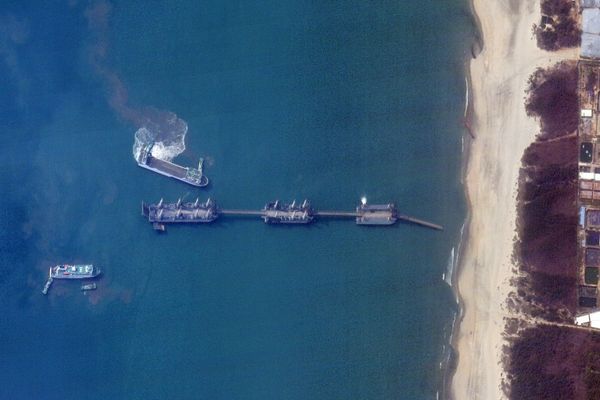A historic heat wave is affecting the West, breaking all-time, monthly and daily records and putting the California electricity grid to test. The heat is relentless, potentially peaking Tuesday but sticking around straight through the upcoming weekend.
The big picture: The immediate cause of the heat wave is an unusually strong area of high pressure, or heat dome, that is parked over the western U.S., causing air to sink and dry out, stifling any widespread rainfall.
- More than 50 million people were under extreme heat warnings and advisories across the western third of the Lower 48 states as of Wednesday morning.
- "Following another day of record heat on Tuesday from California to the central High Plains, expect sizzling temperatures to stick around through mid-week," the National Weather Service warned in a forecast early Wednesday.
Threat level: California ISO, the state's grid operator, on Tuesday afternoon declared a Stage 2 emergency. It raised the alert in the evening to Stage 3, warning rotating power outages were "very possible."
- The state managed to avoid widespread rolling blackouts, but Gov. Gavin Newsom warned in a statement late Tuesday "we aren't out of the woods yet. We will see continued extreme temps this week."
- A Flex Alert was in effect for a seventh-straight day on Tuesday, calling on residents to conserve energy between 4 and 9 pm PT.
- On Monday, California ISO declared a separate Stage 2 emergency, switching on emergency generating capacity as demand threatened to exceed supply.
- Much of this emergency energy supply comes from natural gas plants, including generators meant specifically to kick on in events such as this one.
- Stage 3 emergencies trigger load shedding, otherwise known as rolling outages.
By the numbers: Here are some of Monday's notable records in California:
- 117°F: High in Ukiah, setting an all-time record temperature.
- 116°F High at Sacramento downtown, breaking the record set earlier on Monday of 115°F that smashed the old all-time high temperature of 114°F, dating back to 1925.
- 114°F: High at Sacramento Executive Airport, smashing the old monthly record of 109°F, set just two years ago.
- 115°F: High at Vacaville, beating the old monthly record by 3°F.
- 117°F: High in Fairfield, setting an all-time record.
- 112°F: High in Stockton, setting a monthly record.
Forecast or achieved high temperatures for Tuesday:
- 109°F: San Jose, setting an all-time record.
- 104°F: Oakland
- 125°F: Death Valley
- 94°F: Los Angeles (downtown)
🥵 You though it was hot yesterday??? Today is going to be even hotter!!! Several weather stations may break all-time record highs. Make sure you're prepared to #BeatTheHeat this week. #cawx pic.twitter.com/sUR2SOsZYC
— NWS Sacramento (@NWSSacramento) September 6, 2022
Between the lines: This heat wave is further drying out vegetation that was already desiccated from a 22-year-long megadrought. A widespread region in the West, from California to Washington and eastward across the entire state of Montana is facing significant wildfire threats today.
- On Monday, southern California's fast-moving Fairview Fire killed two people as it grew by 500 acres in one hour.
- The blaze, about 80 miles east of Los Angeles, grew to 2,000 acres by late Monday, the Riverside County Fire Department tweeted.
- Riverside County officials issued evacuation orders for some 5,000 homes, per Cal Fire.
The bottom line: "This heat wave is on track to be both the hottest and the longest on record for this state and many parts of the West for the month of September," Newsom said in an online video Tuesday.
Zoom in: Firefighters are tackling 56 large fires across the U.S., according to the latest information from the National Interagency Fire Center.
- Two people were killed in the Mill Fire over the weekend as it tore through the rural Northern California community of Weed.
- The Mountain Fire Siskiyou County, near the Oregon border, has burned 11,690 acres and was 30% contained on Tuesday morning, per Cal Fire.
- More fires are expected to ignite Wednesday and could grow rapidly in size, exhibiting extreme behavior.
- The heat presents a health risk to firefighters, as well as adding to the fire danger overall.
Context: Heat waves are becoming more common, more intense and longer-lasting due to human-caused global warming.
- Some studies, in fact, have shown that certain extreme heat events would have been virtually impossible without the climate change component.
- While attribution studies on this event will wait until after it winds down, the large area the heat wave is affecting, along with the record strength of the heat dome and the hot temperatures, all bear the hallmarks of a climate change-influenced extreme event.
What to expect: Numerous daily record high temperatures are still likely to be broken from the northern Rockies and High Plains on south to southern California this week — with central and southern California likely to be the hottest places.
- "Wednesday's hottest temperatures compared to normal are expected to setup in the Snake River Valley and Northern High Plains where high temperature departures range between 20-30 degrees above normal," the National Weather Service notes.
- "In addition to the stifling daytime high temps, nighttime lows will not provide much relief as minimum temperature departures also range between 15-30 degrees above normal."
Editor's note: This story has been updated with new details throughout.







